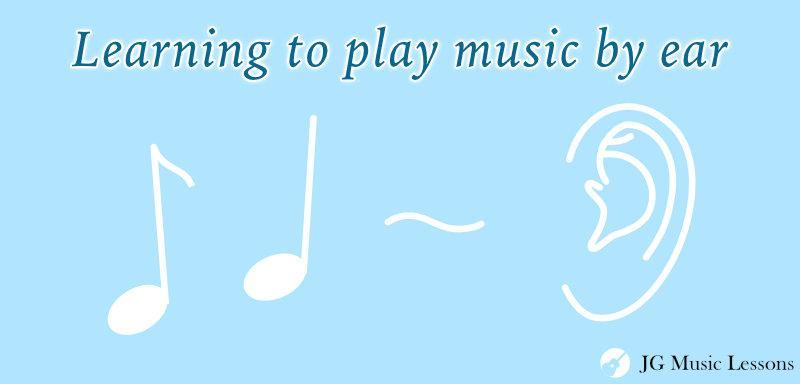Have you ever wondered how certain people seem to be able to play a song after only listening to it for a short while? This is when someone has learned how to play music by ear, meaning that they can learn the chords or melody to a song without having any sheet music.
The truth is that it takes time and practice to listen to a piece of music and translate it to your instrument. To help you learn how to approach this process, this post covers 6 tips on how to learn to play music by ear with audio and chart examples.
1. Identify the key parts that stand out
You want to determine things like: Does the song have a repetitive melody or rhythm that sticks out to you? These are areas you can start focusing on to learn any song and then gradually learn other parts. This may be a simple melody in the intro of a song, a repetitive bass line, or a rhythm you hear from the chords of a song.
I recommend starting with the bass notes or melody because it can tell you what key you are in and what scales you can use (more on this later).
Of course, every song has different instrumentation, which is why I mention that you need to highlight the parts that stand out to you. Maybe you only want to learn the harmony, meaning the chords of a song, which is a slightly different process that I talk more about in the 4th tip here in the post.
If you want to connect a melody and chords, the following tips will also apply but keep in mind that this skill will take some time to develop.
Audio example
Take this short recording for example and see what stands out to you. I’ll write out the notation at the end of the post but first I’ll go through the steps to show how you can go about learning these chords by ear.
When first hearing the audio, you can start to ask yourself things like: how many chords are there in the sequence? What time signature is it in? How many times do the chords repeat? And so on… You’re simply getting a feel of what the music is like in the beginning stages of learning the music.
Learning the rhythm in a song
Don’t worry if you can’t write anything out yet, the most important thing is to pick up the key parts by hearing and singing along. Being able to notate rhythms and pitches of notes will come with some practice. If you were able to figure out the rhythm of the audio clip which happens to be in a 6/8 time signature, the notation would look something like this.

2. Sing back parts: If you can hear it, you can play it
I recommend playing back short sections of a song over and over until you sing or hum back those parts. You don’t have to be a good singer to do this but what you’re trying to do here is trying to match the rhythms and/or melody notes before you play them on your instrument. If you can hear those parts, the next step will be to translate the music to your instrument.
Even if you don’t know the notes on your instrument or don’t know any music theory yet, you should be able to start matching notes according to what you’re hearing.
Some people like to write things out as they are hearing and learning a song. This can be very beneficial to understand a song as a whole and to remember specific parts when you come back to it. This is called ‘transcribing’, the act of notating music according to what you hear.
In addition to being able to hear certain notes, if you understand how scales work, it will be way easier to figure out the rest of the notes of a song. This leads us to my next point.
Learning the bass part
At this point, you may be able to hum back the bass notes in the audio example you heard in the previous section. It may look something like this so far:

3. Use scales as a guide map
After figuring out a couple of notes in a section, you can begin to determine a song’s key center. This will help you determine what scales are being used, meaning the set of notes that can make up the melody or other parts of a song. Most songs are usually based on the notes of a Major scale or minor scale. You can think of the first note as the key center.
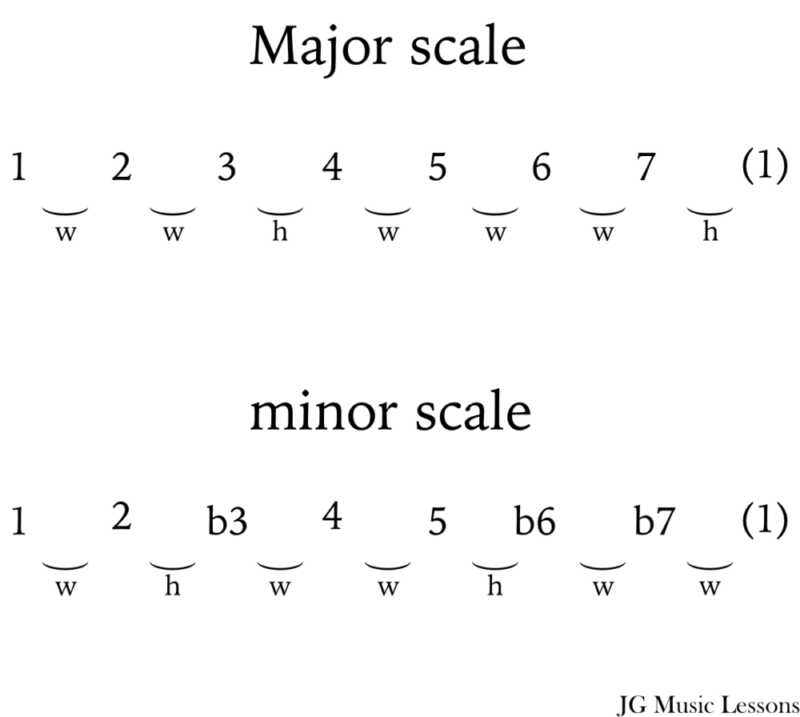
Let’s take D as a starting note for the Major scale you see above. We would get the notes: D, E, F#, G, A, B, and C# to make up the D Major scale.
How about a D minor scale? Following the minor scale formula, you would get the notes: D, E, F, G, A, Bb, and C to make up the D minor scale.
You can apply these formulas to start on any note.
With these scale formulas in mind, you can see how it takes away a lot of the guessing element when figuring out notes. It provides a kind of map to help you figure out melody lines and other instrumental parts.
Keep in mind that some songs can switch between keys throughout a song but generally, a lot of popular songs stay within one key or scale.
You can check out this other lesson to learn the 5 Major scale shapes on guitar or how to play minor scales on guitar.
Find the key of the song
For the audio example that we’ve been learning, since there are no sharp or flat notes yet, we can assume that we are in the key of C since it’s the only key signature without any accidentals (meaning sharps or flats).
4. Learn one part at a time
This depends on what you’re trying to do but you can continue to add parts of a song to your instrument as your ability improves. Again, if this is new to you, start with one part, whether it’s the bass or melody before trying to do two things at once.
If you can find a way to play each part on their own, then you can start to figure out how to play the parts at the same time. This will take experimenting since you have to figure out positions on the fretboard that are suitable to play different parts together.
For example, on guitar, you can play the same set of notes in many different areas of the fretboard. So when you’re adding a second part, you have to specifically rearrange notes to put parts together in a more practical way for your fretting hand.
Once you get the melody and bass parts down, then you can focus on the chords which define the harmony of a song. At this point, we’ll need to understand what diatonic chords are to help us out with the audio example.
5. Find the chords of a song or progression
Chords help us to connect different parts of a song and also provide a context for the melody.
For example, if you already know you are in a specific key and know the bass notes of a section, you can generally figure out the chord qualities (i.e Major or minor) if you understand what the related chords are (also known as diatonic chords). Diatonic chords are essentially chords that are related to one scale.
For example, in C Major, you have the notes C, D, E, F, G, A, B. If you create triad chords (three notes) built on each note by skipping a note of the scale you get:
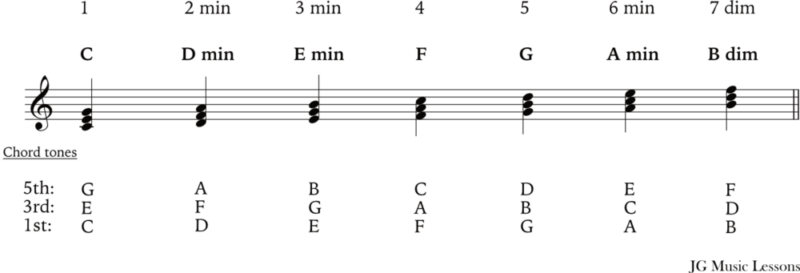
You can think of the bass notes as root notes for any of these chords. So, if the bass line goes:
F / A / D / G
You could first try adding the chord qualities derived from the C Major scale and see if they match the chords of the song you’re learning.
They would turn out to be F Major, A minor, D minor, and G Major.
If some chords don’t fit the song, there are other things to explore such as chord inversions, secondary chords, or slash chords.
Note that you also have songs that are based on minor scales, which technically has the same notes of a Major scale starting on the 6th degree.
For example, the A minor scale has notes A, B, C, D, E, F, and G.
These are some triad chord structures derived from both Major and minor scales:
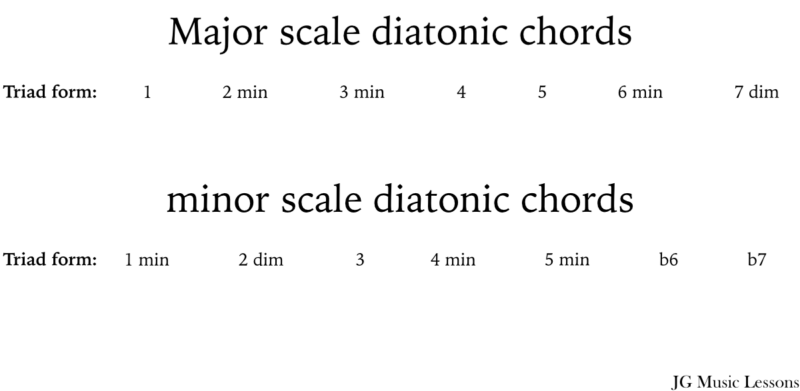
Dim stands for diminished which is a triad chord built on the notes 1, b3, and b5. For example, the notes of a G diminished triad are G, Bb, and Db.
See this other lesson to learn all the related chords in every Major and minor key.
Learning the chords
Using this tool of related chords coming from the same scale, we can also try applying this to the bass notes we figured out earlier. Since there are no sharps, you can start assuming that you are in the key of C. Now, we’ll fill out the chords according to the bass line so far. Also, think of the notes with slashes as the notes we still have to figure out. It would look like this:

6. Playing along with the song
After figuring out some sections of a song, I recommend playing back those parts with the audio. This is an excellent way to practice so you can check if the notes you’re playing are matching the song.
Playing along with the song also helps you get a better sense of the rhythm/groove because you can hear what you’re playing in context with other instruments.
If you can slow down the music that you’re working on, that would be ideal so that you can master playing back something at a slow tempo and then gradually increase the speed. If you’re using YouTube, try this playback feature where you can set the speed to .25, .5, .75, and 1x speed. You also have free programs like Audacity where you can open up a song and change the tempo of a song for practice and learning material.
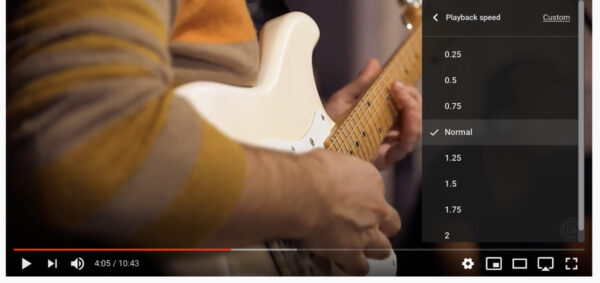
Slowed down audio example
Speaking of changing tempos to learn a song, try hearing a slowed-down version of the audio clip example we’ve been working on learning by ear. It will be much easier to pick up the missing notes in each chord.
Final audio notation
Finally, here is the complete notation of the audio clip we heard at the beginning of this post. The chords are written above the staff lines to indicate the harmony (meaning the chords implied by the melody in each measure).
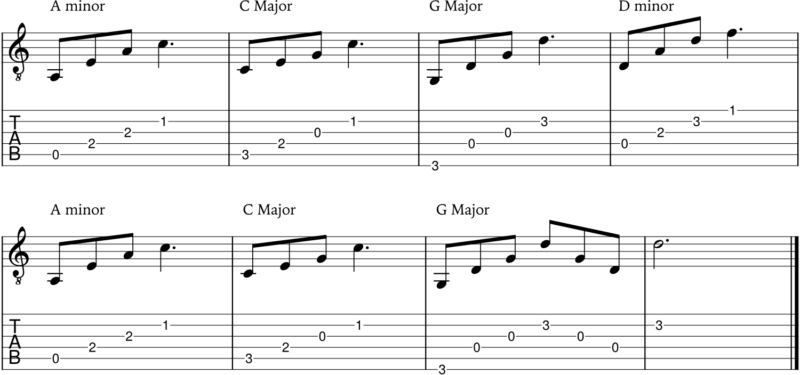
Wrapping up
Although playing songs by ear is a process that takes time and skill to get better at, it becomes very gratifying when you can pick up a song that you like by ear. This skill will take your musicianship to the next level.
To review what we covered in this post, the six tips to playing by ear are:
1. Identify the key parts that stand out in a song.
2. Sing back parts to identify the melody notes or other instrumental parts
3. Use scales as a guide map
4. Learn one part at a time
5. Find the chords of a song or progression
6. Playing along with the song
Remember that these tips may not always follow this exact order because you may want to learn specific parts like only chords, or only a melody. I hope this post gave you some ideas on how to learn music by ear!
You may also want to check out this post on the power of listening to unlock your instrument.
📘 Get the free guitar practice guide here!
All the best on your musical journey,
JG Music Lessons
📙 Kickstart your guitar playing with our step by step guide: Guitar Essentials.
🎸 Looking for a travel or half-sized guitar? See this one.
🛠 See our other music recommendations.
🤝 Support the site to help us to create better content for you!
Level up with the FREE guitar practice guide and effectively improve your playing! 🎸
Get it sent to your email!

